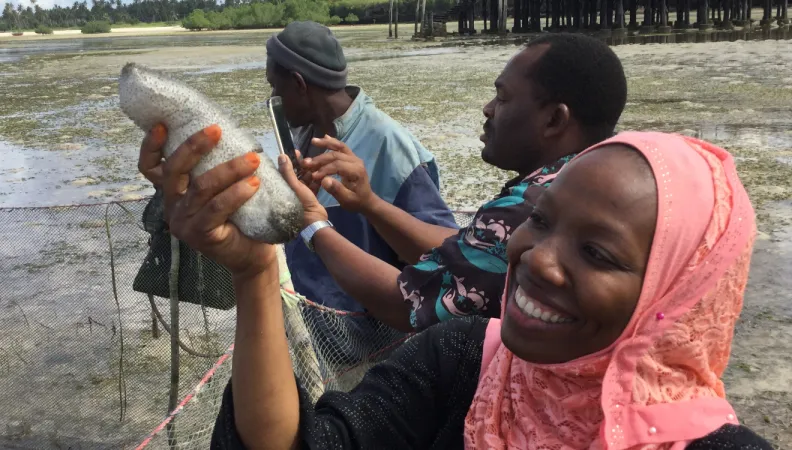Share the page
Aquaculture in Zanzibar: Providing Work and Protecting the Coastline
Published on

On the Zanzibar Archipelago, an ambitious pilot project aims to help coastal communities preserve natural resources while they make a living. Among them are aquaculture farmers specializing in seaweed production. It’s all part of the AquaCoCo project – Aquaculture, Coastal Communities and Conservation – which aims to give locals an invested interest in managing shared – and fragile – ecosystems.
Aysha Hamadi is a seaweed producer in the tidal zone on the Zanzibar coast, who farms using the “cylindrical net” technique. On land, young plants are inserted into nets, taken out a few cable lengths (500 to 600 metres) from shore, and then immersed in six or seven meters of water, where cooler temperatures stimulate plant growth.
But Aysha doesn’t plan to stop there: “To earn more money, I’d like to learn how to swim so I can better understand the way seaweed is transformed. I’d also like to be trained on how to grow sea cucumbers.”
Aquaculture in Zanzibar: A Changing Sector
According to the International Union for Conservation of Nature (IUCN), about 80% of seaweed farming is done by women.
In partnership with Agence Française de Développement, the IUCN has created the “Oceans, Islands and Coasts” initiative, which includes the AquaCoCo pilot project. It’s part of the work undertaken by the IUCN since 2014 on aquaculture and Protected Marine Areas, which helps Tanzania’s semi-autonomous state of Zanzibar manage marine resources in sustainable ways.
Seaweed production in the archipelago was massively adopted by local women some twenty years ago. They were often the wives of fishermen who saw seaweed growing as a way to supplement household income. But the traditional method of growing plants on the edge of the beach and harvesting them at low tides, has its limits. It’s not only extremely hard physical labor; warming ocean waters near the shore were leading to diminishing returns.
What's more, over-fishing has prompted locals to seek alternatives, such as sea cucumber breeding. Thus a potential crisis has given rise to new methods – such as Aysha Hamadi’s cylindrical nets – which protect ecosystems, particularly in the face of climate change.
AquaCoCo Zanzibar is the subject of a short documentary and a report on the theme of Aquaculture and Conservation.
Working Together to Protect Coastal Resources
In sectors like fishing and tourism, economic and environmental issues are now inseparable. Preserving the coasts of Zanzibar means ensuring the long-term survival of an ecosystem as much as it does providing a means of subsistence.
By bringing private sector stakeholders to the table with local authorities representatives and IUCN researchers, the AquaCoCo project provides a basis for the sustainable joint management of coastal areas.
“Only an integrated development approach can promote resilience and social and environmental equity,” says Aboud S. Jumbe, Head of Zanzibar’s Environment Department. “Without it, protected marine areas in Zanzibar will continue to become more and more vulnerable.”
The upcoming IUCN World Conservation Congress at Marseille in June 2020 is casting the relationships between coastal communities, aquaculture and sustainable development into sharp relief.
